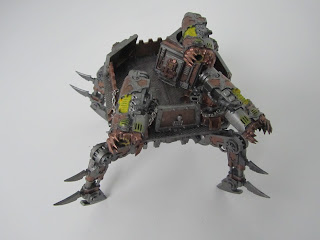The last additions that I wanted to share in this set of updates are a pair that were created together: my twin heldrakes, the Cry of Oblivion and the Roar of Despair.
The original idea to create these heldrakes actually came well before I started my Dark Mechanicum project. After the release of the 6th edition chaos space marines codex, and the new daemon engines, I was speaking with a friend who mentioned his disappointment with the heldrake model.
In particular, he noted that the options for customising and posing the model were very limited, which I had also found to be the case with its options in the codex.
For some reason following this, I decided to take on the challenge of creating two clearly different heldrakes and see if I could overcome some of its limitations. These models then became the centrepiece of a slaaneshii chaos space marine army full of various winged units and jump infantry.
Later on, I then repainted their armour to add them to my growing Dark Mechanicum force, but decided to keep the lilac flesh underneath unchanged.
After years of repairing and strengthening the fragile wings, I have my doubts about whether they were the best idea, but I still think they are some of the most impactful conversions that I have managed.
The Cry of Oblivion has two large wyvern-like wings in the place of its arms, while the wings of the Roar of Despair form an X-shape on its back and leave space for two sets of the larger legs. I also used maulerfiend heads on both, as I felt they gave a more slender, predatory appearance.
The wings of the Cry of Oblivion had to be fixed in place due to their size and downward angle, but I was able to pin each wing of the Roar of Despair rather than gluing them (which is hidden by the top-armour). This makes it possible to safely remove them for storage and transport which has helped immensely.
















